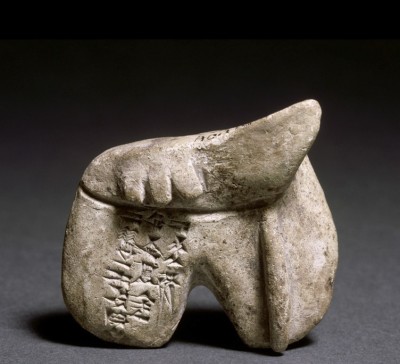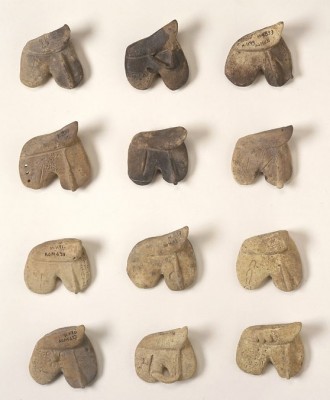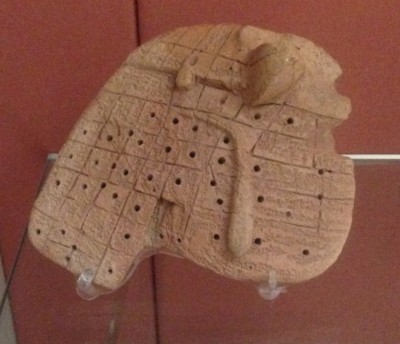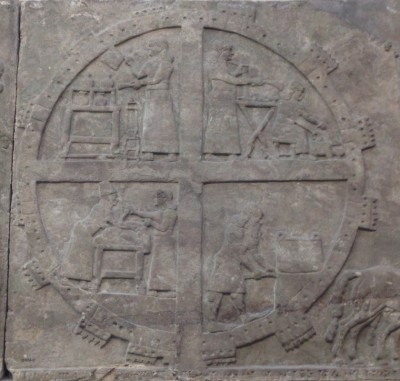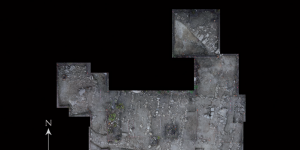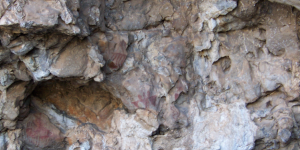‘’When the country rebelled against Ibi-Sin, the liver appeared like this’’
Inscribed on Mari Liver Model number 7 F II (Figure 1).
Divination today is seen as superstition, but in many past cultures of the Near East, it was seen as a way to communicate with the divine. Such belief is connected to the production of liver models, like the ones found by the French archaeologist André Parrot at Mari, Syria, dated to the 19th and 18th century BC. These 32 clay models (Figure 1 and 2) were excavated, with other tablets, during the French campaign of 1935–36 in room 108 of the Royal Palace of Mari. These objects are clay models representing livers from sacrifices, and are thought to represent real examples, reproduced shortly after the ceremony had taken place. It is quite common for them to have inscriptions describing the meaning of the features the liver had. The ancient Babylonians believed in fact that the liver was the seat of thought, and that the gods would manifest their answer in the healthy liver of a sacrificial animal (Collins 2008, 320).
Liver models are related to the wider practice of extispicy – the study of animal entrails – but hepatoscopy – the study of the sole liver – was regarded as a higher discipline (Pardee 2000). According to various legends, it was the gods who brought extispicy to humans (Koch 2011), and although our first attestations of this practice are the Mari models, evidence from liver omens suggests that it was already performed in the third millennium BC (Benoit 2007).
The actual ritual was complex and expensive. By the first millennium BC, four sacrificial animals were needed. A less studied aspect is the ‘mechanics of sacrifice’ (Robson 2011), which links these objects with various strata of the ancient population, for example in tracing who supplied the animals, how they were chosen, and who paid for them.
Liver models can help us gain a glimpse into Mesopotamian society in almost any period, as the practice survived for millennia, as can be testified by various liver omens and models from different periods. Liver models were found in Babylon (see Figure 3), Mari, Hattusa and Etruria. The geographical spread of hepatoscopy and its influence on Greek and Roman divination (Collins 2008), allows us to see how these cultures influenced each other, and how, with traded goods, beliefs were spread as well.
The Mari models are strongly linked with religion, which in ancient Mesopotamia had different contexts, ranging from state to private, but hepatoscopy was used in both contexts. We know in fact that it was used for state concerns, but in Mari, we also have more common requests, such as if a man should buy a boy as a slave or not. Hepatoscopy shows that the relationship with the gods was a dialogue, where the diviner asked them to show their will in order to act in the most profitable way (Heeßel 2010). Omens in general show us how the future was conceived; differently from the unchangeable destiny of the Romans, in Mesopotamia the very purpose of divination was to be able to act against future threats, and know the will of the gods. Living in harmony with them was beneficial, and thus extispicy was strongly connected with decision-making, especially in state affairs. This is especially true for the Neo-Assyrian Empire where the abundance of evidence shows how divination played a key role in influencing the king’s actions: nothing could be done against a bad omen but postpone the planned project and try again after a reasonable amount of time had passed (Koch 2011). This again stresses how there was little division, if any, between the king, the state, and religion. They were strongly linked together, as the king, as the state, asked the gods an opinion on decisions. During the Neo-Assyrian period in particular, we see how astrology and extispicy played a complementary role, but while astrology was highly debated and various interpretations were given, extispicy was straightforward and diviners never offered more interpretations. Divination was so important that diviners followed the army on expeditions (Koch 2011; Figure 4).
Although the surviving evidence associates divination mostly with the state, divination was probably widely present in people’s daily lives. Lesser forms of divination, like lecanomancy (explored in Issue 36 by Alex Loktionov), were generally used for more common matters (Benoit 2007). Omens also had an impact on political, military, economic and cultural state matters, but these would have strongly affected people’s lives. Omens for private matters can be studied through Neo-Assyrian tamitus texts. Unfortunately they never mention actual sacrifices, thus it is debatable whether we can consider them extispicies.
Liver models also allow us to understand, partially, how the transmission of knowledge worked in ancient Mesopotamia, and how the training of new diviners worked. Liver models are associated with tables and lists of omens. Only these two kinds of written material were at the disposal of the diviners. The fact that hepatoscopy appears in written texts as an already established discipline, points to a very long oral phase, during which it established and shaped itself (Richardson 2010, 328).
Furthermore, models and texts allow us to trace the anatomical understanding that the ancients had developed of the liver, although in this we are still hindered by the poor understanding of many terms (Biggs 1969). While there was not a medical understanding of the liver, whose function was mistaken by the ancients, it is interesting to note how modern terminology of the liver parts has its roots in Babylonian terms (Martins and A. Cavalcanti 2012).
The liver models from Mari are a testimony to a complex and long-lived tradition of hepatoscopy and, more generally, divination in the Ancient Near East. They are very important evidence, along with omen tablets, that allows archaeologists and historians to reconstruct and understand various aspects of the lives of people throughout the millennia. As these beliefs were common to the whole population, not only the elite, the models are a useful tool for social analysis as well as the study of religion. Omens and liver models depict popular beliefs, state religion, and how ancient inhabitants of Mesopotamia saw their relationship with the gods. The conception of the future, and the fact that men could act to prevent negative outcomes, is the reason for the long life of this practice and its presence in almost every aspect of life. It also greatly influenced decision-making, colouring the picture of kings’ political and military strategies. Divination was an important “stabilising factor” (Heeßel 2010) and eliminated “disorder in social relationships” (Park 1963). This is true, and is another factor that strengthened the importance of this practice, but we should also see it foremost from an ancient perspective: a way to communicate with the gods and be the good servants of the gods, which humans were created to be. In the light of what has been considered so far, the Mari liver models offer a fascinating insight into ancient Mesopotamian life and religion.
Bibliography
- Beckman, G. (1983). Mesopotamians and Mesopotamian Learning at Ḫattuša. Journal of Cuneiform Studies, 35(½), pp. 97–114.
- Benoit, N. (2007). Ancient Divination [online] Available at: http://www.louvre.fr/en/oeuvre-notices/model-liver-divination [Accessed 6 December 2013]
- Biggs, R. D. (1969). Qutnu, maṣraḫu and related terms in babylonian extispicy. Revue d'Assyriologie et d'archéologie orientale, 63(2), pp. 159–167.
- Collins, D. (2008). Mapping the entrails: the practice of Greek Hepatoscopy. American Journal of Philology 129(3), pp. 319–346.
- Heeßel, N. P. (2010). The Calculation of the Stipulated Term in Extispicy. In A. Annus, Divination and Interpretation of signs in the Ancient World. Oriental Institute Seminars 6. Chicago: The Oriental Institute, pp. 163–176.
- Koch, U. S. (2011). Sheep and Sky: Systems of Divinatory Interpretation. K. Radner and E. Robson (Eds). The Oxford Handbook of Cuneiform Culture, pp. 447–469.
- Martins, C. and A. Cavalcanti de A. Martins (2012). History of Liver Anatomy: Mesopotamian liver clay models. International Hepato-Pancreato-Biliary Association, pp. 322–323.
- Pardee, D. (2000). Divinatory and Sacrificial Rites. Near Eastern Archaeology, 63(4), pp. 432–234.
- Park, G. K. (1963). Divination and its social context. The Journal of the Royal Anthropological Institute of Great Britain and Ireland 93(2), pp. 195–209.
- Richardson, S. F. C. (2010). On seeing and Believing: Liver Divination and the Era of Warring states (II). In A. Annus (Eds). Divination and Interpretation of signs in the Ancient World. Oriental Institute Seminars 6. Chicago: The Oriental Institute, pp. 225–266.
- Robson, E. (2011). Empirical Scholarship in the Neo-Assyrian Court. G. J. Selz (Eds). The Empirical Dimension of Ancient Near Eastern Studies, pp. 603–630.
- Rutten, M. (1938). Trente-deux modèles de foies en argile inscrits provenant de tell-hariri (mari). Revue d'Assyriologie et d'archéologie orientale 35(1), pp. 36–70.


